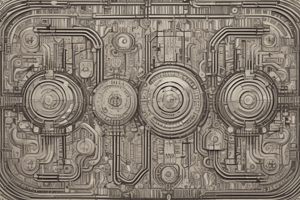Podcast
Questions and Answers
What is the characteristic of the graph of current vs. voltage for ohmic conductors?
What is the characteristic of the graph of current vs. voltage for ohmic conductors?
- A straight line (correct)
- A parabolic line
- A curved line
- A zigzag line
What happens to the resistance of non-ohmic conductors when the temperature changes?
What happens to the resistance of non-ohmic conductors when the temperature changes?
- It changes randomly
- It decreases
- It increases (correct)
- It remains the same
In a series circuit, what is the relationship between the total resistance and the resistances of individual resistors?
In a series circuit, what is the relationship between the total resistance and the resistances of individual resistors?
- Rs = R1 × R2 × R3 × ... × Rn
- Rs = R1 + R2 + R3 + ... + Rn (correct)
- Rs = R1 / (R2 + R3 + ... + Rn)
- Rs = R1 - R2 + R3 - ... + Rn
What is the same for all components in a series circuit?
What is the same for all components in a series circuit?
How is the total resistance in a parallel circuit calculated?
How is the total resistance in a parallel circuit calculated?
What is the same for all components in a parallel circuit?
What is the same for all components in a parallel circuit?
How is the total current in a parallel circuit calculated?
How is the total current in a parallel circuit calculated?
What is the correct order of operations when analyzing a circuit with multiple series and parallel components?
What is the correct order of operations when analyzing a circuit with multiple series and parallel components?
What is the unit of measurement for the amount of energy per unit charge?
What is the unit of measurement for the amount of energy per unit charge?
What is the relationship between current, voltage, and resistance in a circuit according to Ohm's Law?
What is the relationship between current, voltage, and resistance in a circuit according to Ohm's Law?
What happens to the resistance of an ohmic conductor when the voltage is varied across it?
What happens to the resistance of an ohmic conductor when the voltage is varied across it?
What is the graph that results from plotting voltage on the x-axis and current on the y-axis?
What is the graph that results from plotting voltage on the x-axis and current on the y-axis?
What is an example of a non-ohmic conductor?
What is an example of a non-ohmic conductor?
What is the definition of electrical current?
What is the definition of electrical current?
What happens to the resistance of a conductor when its temperature changes?
What happens to the resistance of a conductor when its temperature changes?
What is the formula for calculating resistance?
What is the formula for calculating resistance?
What is the fundamental quantity that Ohm's Law relates?
What is the fundamental quantity that Ohm's Law relates?
What is the condition for the resistance of a conductor to be constant?
What is the condition for the resistance of a conductor to be constant?
What type of conductor does not obey Ohm's Law?
What type of conductor does not obey Ohm's Law?
What is the effect of increasing the voltage across an ohmic conductor?
What is the effect of increasing the voltage across an ohmic conductor?
What is the formula that describes the relationship between current, voltage, and resistance in a circuit?
What is the formula that describes the relationship between current, voltage, and resistance in a circuit?
What is the definition of resistance in a circuit?
What is the definition of resistance in a circuit?
What is the characteristic of ohmic conductors?
What is the characteristic of ohmic conductors?
What is an example of an ohmic conductor?
What is an example of an ohmic conductor?
What is the main difference between ohmic and non-ohmic conductors?
What is the main difference between ohmic and non-ohmic conductors?
What is the total resistance in a circuit with three resistors in parallel, each with a resistance of 2 ohms, 3 ohms, and 4 ohms?
What is the total resistance in a circuit with three resistors in parallel, each with a resistance of 2 ohms, 3 ohms, and 4 ohms?
In a series circuit with two resistors, what is the relationship between the voltage across each resistor and its resistance?
In a series circuit with two resistors, what is the relationship between the voltage across each resistor and its resistance?
What is the current through each component in a series circuit?
What is the current through each component in a series circuit?
How do you analyze a circuit with multiple series and parallel components?
How do you analyze a circuit with multiple series and parallel components?
What is the formula for the total resistance in a series circuit with n resistors?
What is the formula for the total resistance in a series circuit with n resistors?
What is the current through each parallel path in a parallel circuit?
What is the current through each parallel path in a parallel circuit?
What is the voltage across each component in a parallel circuit?
What is the voltage across each component in a parallel circuit?
What is the primary reason why the resistance of an ohmic conductor remains constant?
What is the primary reason why the resistance of an ohmic conductor remains constant?
What is the relationship between the voltage and current in a non-ohmic conductor?
What is the relationship between the voltage and current in a non-ohmic conductor?
What is the unit of measurement for the rate of flow of charge through a circuit?
What is the unit of measurement for the rate of flow of charge through a circuit?
Which of the following is NOT a characteristic of ohmic conductors?
Which of the following is NOT a characteristic of ohmic conductors?
What is the physical quantity that is measured by the voltage across a conductor?
What is the physical quantity that is measured by the voltage across a conductor?
What is the condition for the current flowing through a conductor to be proportional to the voltage across it?
What is the condition for the current flowing through a conductor to be proportional to the voltage across it?
What is the relationship between the voltage and current in a circuit according to Ohm's Law?
What is the relationship between the voltage and current in a circuit according to Ohm's Law?
What is the difference between ohmic and non-ohmic conductors?
What is the difference between ohmic and non-ohmic conductors?
What is the primary difference between the total resistance in a series circuit and a parallel circuit?
What is the primary difference between the total resistance in a series circuit and a parallel circuit?
In a circuit with two resistors in series and one resistor in parallel, what is the correct order of operations to calculate the total resistance?
In a circuit with two resistors in series and one resistor in parallel, what is the correct order of operations to calculate the total resistance?
What is the relationship between the voltage across each resistor and its resistance in a series circuit?
What is the relationship between the voltage across each resistor and its resistance in a series circuit?
What is the primary advantage of using parallel circuits over series circuits?
What is the primary advantage of using parallel circuits over series circuits?
What is the consequence of combining multiple resistors in series?
What is the consequence of combining multiple resistors in series?
What is the characteristic of the graph of current vs. voltage for non-ohmic conductors?
What is the characteristic of the graph of current vs. voltage for non-ohmic conductors?
What is the relationship between the total current and the currents through each resistor in a parallel circuit?
What is the relationship between the total current and the currents through each resistor in a parallel circuit?
What is the condition for a conductor to be classified as ohmic?
What is the condition for a conductor to be classified as ohmic?




